 By Pepper Parr
By Pepper Parr
August 5, 2015
BURLINGTON, ON
When the draft of the Transportation Master Plan was put before city Council, which was meeting as a Committee of the Whole, Councillor Taylor commented that “it was a lot to take in at one sitting – and indeed it was.
The presentation itself took well over an hour with Interim Director of Transportation Vito Tolone working as a tag team with planner Kaylan Edgcumbe.
The gist of it all was that the intensification the city was going to have to undergo to absorb its share of the 1 million additional residents the Region of Halton was going to have to accommodate between now and 2031 meant a level of congestion “Burlington didn’t have much tolerance for”.
In surveys done by the Transportation department there were two almost diametrically opposed sets of comments – one from the over 55 set and another from high school students.
Using the dictum that a picture is worth a thousand words the two graphics below tell very different stories.
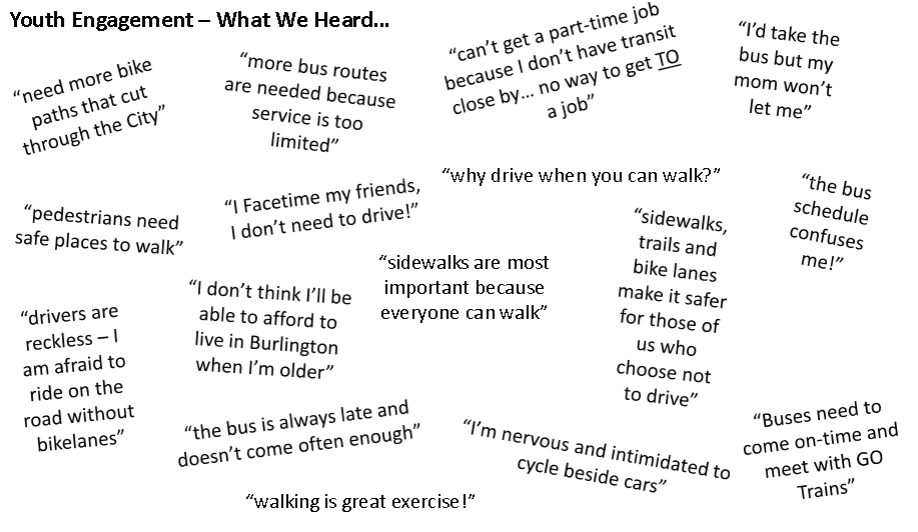
Hundreds of students responded to the questionnaire that asked for comments on modes of transportation.
The planners and the transportation experts needed to know how high school students looked at public transit. They knew that the older than 55 set thought – getting them out of their cars was going to require crow bars.
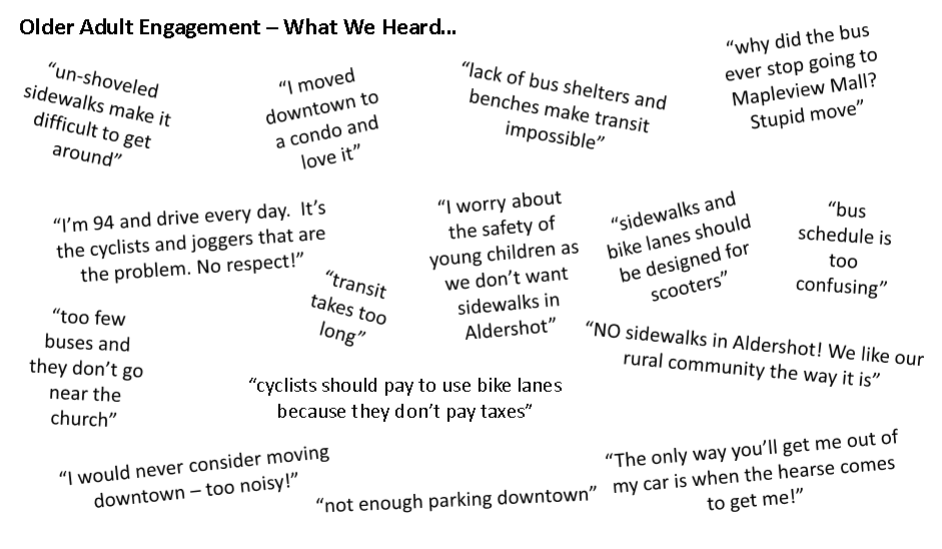
The Senior set didn’t appear to be ready for much in the way of change. Transportation staff made the observation that “Burlington doesn’t have much tolerance for traffic congestion” Without a change in the use of transit – congestion is about all we have to look forward to.
The transportation met with the principal at Charles Beaudoin school and asked if they would participate in a “bike” week program with the city. “The principal wasn’t all that keen on the idea at the beginning” explained Tolone “but he came around and we learned a lot – they also learned what they needed to know, which was that younger people weren’t married to the car to the same degree as their parents.
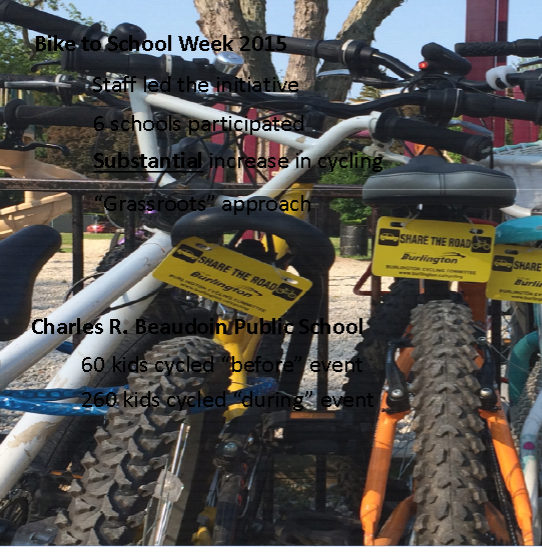
Bike to school week at the Charles Beaudoin school saw a very strong uptake on bike use that held after the event. Can it be made an ongoing habit?
The week before “bike week” there were 60 students at Beaudoin using their bikes to get to school. During bike week there were 260 using their bikes. After bike week more than 75% of that additional 200 were riding their bikes to school.
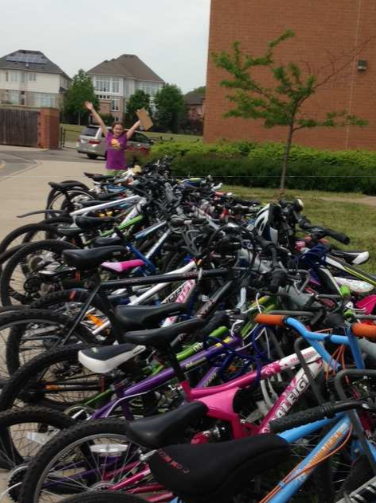
This is the kind of congestion the transportation department wants to see.
Tolone saw hope on the horizon. His research tells him that with intensification now an inevitability and no room to build additional road capacity – and no desire on the part of the city to do so either – other ways had to be found to move people around.
Expect to hear a lot of the phrase “complete streets” added to the “modal split” we are already hearing about.
Last week the province introduced that acronym HOT for high occupancy toll lanes – if you want to use those lanes intended for high occupancy vehicles with just one passenger in the car – you pay a toll.
The longer term objective is “behaviour change” we just don’t have the road capacity to handle the traffic that intensification will bring with it.
Councillor Taylor opined that the number of people the Region is going to set as the Burlington target will amount to 100 Stratas – a bit of an exaggeration perhaps but he made his point.
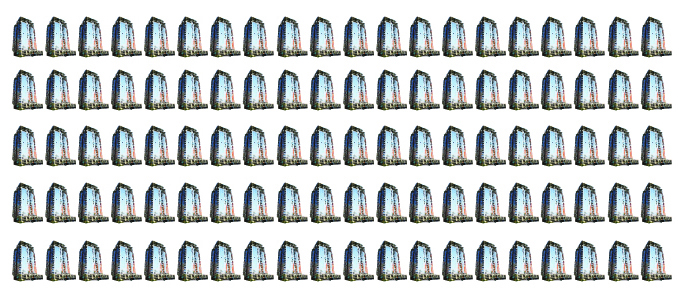
Councillor John Taylor said there would have to be an additional 100 towers the size of the strata on Maple Avenue – claims he has the data to back that up.
Strata is the name given to the Molinaro condominium of Maple Avenue.
The Committee of the Whole meeting was short two of its members – Councillors Dennison and Meed Ward were not present. Meed Ward was recovering from the concision she suffered when her car was rear ended.
At the conclusion of what was a long meeting city general manager Scott Stewart made the comment that “this is a web cast we will be looking at more than once”. Indeed they will because there was no clear sense of direction from the five members of Council in the room.
Transportation and intensification are words that are now linked together and we are going to hear a lot more about both in the years ahead. In order for the needed changes to be made behaviour is going to have to be changed and in Burlington that is no small matter.















Chris, I can only speak for Appleby Line but South bound during the evening rush hour bottle necks at New St. as everyone moves to the left lane. I question the logic.
There are roughly 22 traffic lights along Appleby Line from the 407 to New St. maybe we require a dedicated North South artery to move traffic along instead of the constant stop start. I’ve noticed more people blow through reds due to frustration. Not very safe.
Currently the plan is nothing more than to transform living in south Burlington into a nightmare.
Also the roads in the north are under regional control and are going to be expanded to 7 lanes by Halton region. Lots more road capacity is comming it’s just all in the north.
It’s Burlington city that can’t manage the roads assigned to it. Perhaps we should place Walkers and Fairview/Plains under regional control as well. In any case – leave space for 7 lanes plus protected bike lanes on all arteries. It’s just common sense.
Having to get across 7 lane roads every day to get to shops and schools sounds like a nightmare for the people in North Burlington too. Not to mention the taxpayers who have to pay for the upkeep of these monstrosities.
Behavioural change is an easy out. How about traffic management behavioural change…..synchronised lights during rush hour, bring back the second lane on Appleby, Walkers and Guelph Lines south of New St. (not sure of the logic of closing them in the first place)Any new road construction allow a wider road to except bike lanes instead of putting them on congested narrow roads as the City does now. More dedicated right turn lanes at key intersections. The reality is we live in a car centric society deal with it and find traffic flow solutions because more bikes and public transport are not going to solve the problem.
If you check staff’s recommendation you’ll find there was very sound logic for transitioning Guelph, Walkers and Appleby south of New. All 3 of those roads do not carry that much traffic on a daily basis and there is no reason to expect there will be an increase as it is already built with mostly single family homes. South of New is not where the bottlenecks are. The streets are also safer, more comfortable to live on and residents find it easier to get in and out with the addition of the left turn lane. The bike lanes don’t connect to anything, so the fact that cycling volumes haven’t gone up significantly on these streets is not surprising.
As for synchronized lights – easier said then done. People want to travel both north/south and east/west in Burlington. Which sets of lights do you sync up? Perhaps some tinkering can be done to improve it but it’s likely marginal at best.
We also have so few continuous arteries that converting to alternate one-ways like they have in Hamilton will just make it that much harder to get around by car. Not to mention the negative impact that turning our streets into de-facto highways will have on businesses, public safety and liveability.
Off the top, behavioural change needs feasible alternatives, of sufficient scale, to change to, and right now there aren’t any that are visible. Not even any realistic ideas that I can see.
We need some quantification of the problem, and John Taylor’s first cut on the population and equivalent housing structure is a start. Transportation needs to do this, but has not.
We need solutions not just problem statements from them.
We need to see the scale of the problem and what can match that.
There is much more to be said on this.
The city is presently interviewing about 40 candidates for the new Integrated Transportation COmmittee to consult with council on this type of secenario but will not announce the members until early October. Again, another solution that becomes available too late to be useful.
——————————————————————
The survey results are useful. Both seniors and youth are confused by info on transit schedules. Busses rely on confidence before people willl commit to using them – – -better information is essential. Lets get with a solution. Why not a Burlington radio station? How can we (our Burlington burocracy) communicate with us, the residents in a way we understand and utilise?